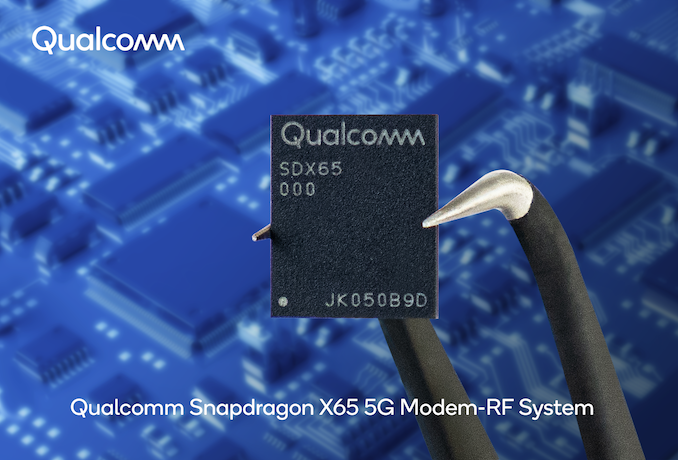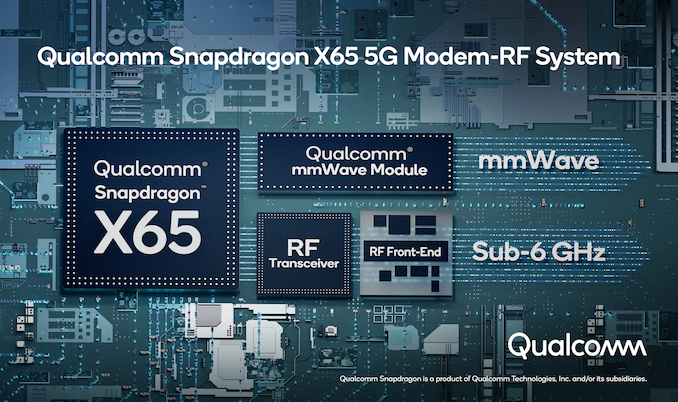Qualcomm Announces X65 & X62 5G Modems on 4nm
by Andrei Frumusanu on February 10, 2021 6:30 AM EST- Posted in
- Mobile
- Qualcomm
- Smartphones
- 5G

Qualcomm yesterday has announced a slew of new 5G communication platforms, representing their next-generation modems, and RF front-end solutions that will be powering the next flagship devices later in 2021 as well as 2022. This includes two new 5G modems in the form of the new Snapdragon X65 and X62, a new RFFE portfolio with new envelope trackers, new antenna tuners, and new power amplifiers, alongside a 4th generation mmWave antenna module that supports more frequency bands and a larger frequency bandwidth.
Starting off with the new X65 modem, it’s a rather large generational upgrade compared to the current X60 modem that increases the amount of frequency bands as well as bandwidth that a vendor can deploy in an end user device.
In terms of sub-6GHz frequencies, the new X65 modem increases the bandwidth from 200MHz to 300MHz, essentially a 50% increase in aggregate spectrum that can be used. Such a wide breadth of spectrum is currently extremely rate in terms of 5G network deployments, but as the US is freeing up new mid-band frequencies for 5G usage over the next years, as well as other global markets deprecate 3G frequencies and reallocate them into 5G usage, we’ll be seeing more possible carrier aggregation combinations across larger variety of frequency bands.
On the mmWave side, things have also seen improvements as the available bandwidth goes from 800MHz to 1000MHz, and now adopts support for the TDD 41GHz n259 band, important for mmWave deployments in countries such as China and Japan.
The new modem, when aggregating across sub-6GHz and mmWave networks with the new increased bandwidth capabilities thus advertises maximum download speeds of up to 10Gbps. Of course, such peak figures aren’t too realistic in the real world, but they do showcase the vast increase in spectrum bandwidth available, which will translate to better transmission speeds in crowded situations.
Alongside the super-high-end X65 modem, we’re also seeing the release of the X62, which is essentially its little brother. In terms of frequency bands and standards capabilities, it’s of the same calibre as the X65, however it differs in terms of its spectrum bandwidth capabilities; sub-6GHz is reduced to 120MHz, and mmWave is reduced to 300MHz across 4 carriers, rather than 10. Undoubtedly this modem solution will be targeting devices at lower price points than the X65 flagship.
Interestingly, both new X65 and X62 modems are manufactured on a 4nm node – this should be Samsung’s 4LPE node which is a further iterative improvement of their current 5LPE technology.
The new 5G modem solutions and their RFFE companion chips are set to hit the market in late 2021.











54 Comments
View All Comments
shabby - Wednesday, February 10, 2021 - link
They have been tested to like 1.5gbps but you need to be standing in front of the tower, pointless but the speed is there.The biggest atrocity is why majority of home routers are stuck with ancient 1gbps ports.
eek2121 - Wednesday, February 10, 2021 - link
I mean, if you want to make that argument, 10 gbit *and* 100 gbit for "home networks" has been available for a decade or more.shabby - Friday, February 12, 2021 - link
And which consumer router has those?rmcrys - Thursday, February 24, 2022 - link
eek2121: I don't know where you live but most manufacturers don't offer nothing more than ONE 2.5 gbit port on modem-routers; I also searched recently for a 10 gbit NAS and router for acceptable prices and I found none. So please tell me which ones you have available unter $300...HardwareDufus - Friday, February 12, 2021 - link
"The biggest atrocity is why majority of home routers are stuck with ancient 1gbps ports."-- real first world problem right there...
rmcrys - Thursday, February 24, 2022 - link
10 gbit POSSIBLE connection doesn't mean existing real connection.But you're right, it's embarrassing that 99.99% of home routers don't even have 10 gbit Lan connecting. Most newer modem routers have ONE single 2.5 gbit port.... in 2022 I would expect a 2.5 gbit internet port and all other 4-6 as 10 gbit., as well most consoles, laptops, etc should have 10 gbit as default. Embarrassing...
sharathc - Wednesday, February 10, 2021 - link
Dafuk? :DSydneyBlue120d - Wednesday, February 10, 2021 - link
Do You think it will be possible to expect in iPhone 2021 based on "late 2021" assumption?dudedud - Wednesday, February 10, 2021 - link
With the current shortcase I'd be surprised if they can meet the demand with the current X60.It would depend entirely on Samsung, but I'm not expecting much as there are even rumors of low yield for the S888 and Exynos 2100 which is 5lppe not even this new 4lppe
romrunning - Wednesday, February 10, 2021 - link
"Interestingly, both new X65 and X62 modems are manufactured on a 4nm node – this should be Samsung’s 4LPE node which is a further iterative improvement of their current 5LPE technology."Just imagine if GloFlo had stayed the course - they would be reaping the benefits of "unprecedented demand" right now. Maybe they would be iterating on their 5nm process tech right now too. I know they had their issues, but they had enough technical talent to iron it out, just like Intel. A short bridge loan might have gotten them over the hump, and now the money they would be making would have easily paid it off.